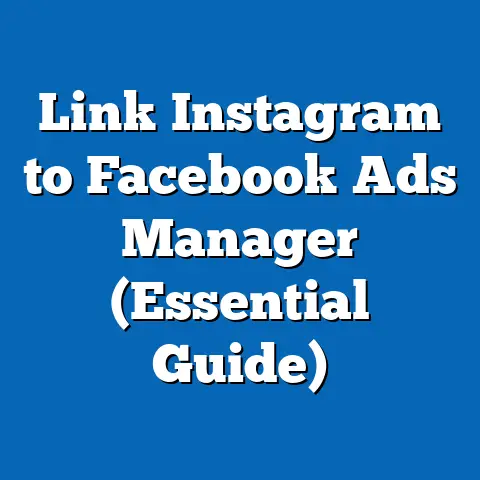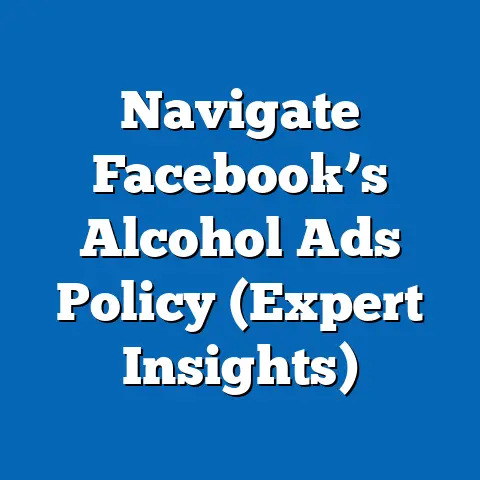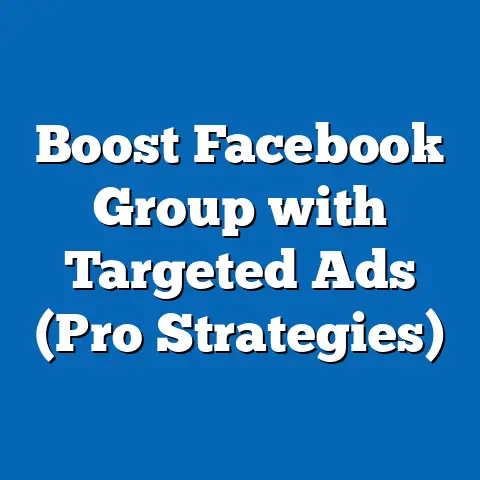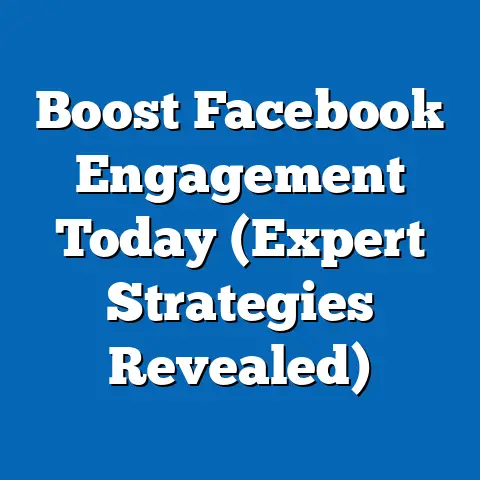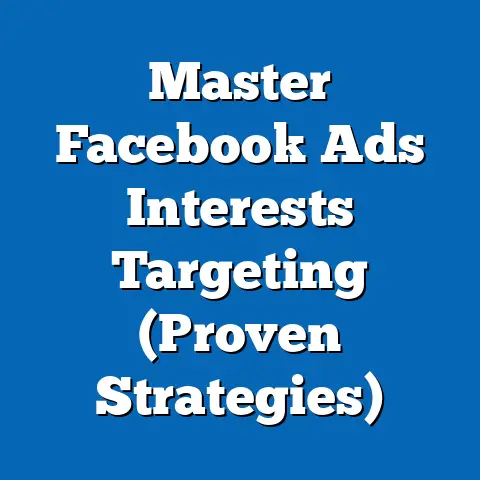Can You Only Advertise to 65 on Facebook Ads? (Insight Revealed)
Have you ever felt like Facebook Ads was a bit of a riddle wrapped in an enigma, sprinkled with frustration? I know I have. One of the most common head-scratchers I hear from fellow marketers, and something I’ve personally wrestled with, is the perceived limitation of targeting younger audiences on Facebook. There’s this nagging misconception that Facebook Ads are only effective for reaching those aged 65 and above. This idea is not only false, but it also holds businesses back from tapping into the vast potential of younger, highly engaged audiences.
I remember one time, I was working with a local clothing boutique that wanted to attract a younger clientele. They were convinced that Facebook Ads wouldn’t work because “everyone on Facebook is old.” I had to show them the data and prove that not only are younger folks still active on the platform, but they’re also extremely receptive to targeted advertising when done right. This experience highlighted how crucial it is to debunk this myth and unlock the real potential of Facebook’s diverse user base.
Facebook Ads Targeting Options: A World of Possibilities
Facebook Ads Manager is a powerful beast, brimming with targeting options that go far beyond just age. It’s like having a Swiss Army knife for your advertising, with tools to reach incredibly specific segments of the population. Let’s break down some of the key targeting parameters:
- Demographics: This is where age comes in, but it’s just the tip of the iceberg. You can also target based on gender, education level, relationship status, parental status, job titles, and more.
- Location: Target people living in specific countries, regions, cities, or even within a certain radius of a physical address. This is gold for local businesses.
- Interests: This is where things get really interesting. Facebook tracks users’ interests based on the pages they like, the content they engage with, and the topics they talk about. You can target people interested in anything from “sustainable living” to “gourmet coffee.”
- Behaviors: This category allows you to target people based on their online behavior, such as purchase history, device usage, travel habits, and more. For example, you can target people who are frequent international travelers or those who have recently purchased a new car.
- Custom Audiences: This is where you can upload your own data, such as customer email lists or website visitor information, to create highly targeted audiences.
- Lookalike Audiences: This is a powerful tool that allows you to find new customers who are similar to your existing customers. Facebook analyzes the characteristics of your custom audience and finds other users who share those traits.
I’ve personally found the “Interests” and “Behaviors” targeting options to be incredibly effective. For instance, I once ran a campaign for a yoga studio, and by targeting people interested in “yoga,” “meditation,” and “wellness,” we were able to attract a steady stream of new students. The key is to think creatively about your ideal customer and identify the interests and behaviors that are most relevant to them.
Facebook’s algorithms are constantly learning and refining their targeting capabilities. They analyze vast amounts of data to identify the most receptive audiences for your ads. As an advertiser, your job is to provide the algorithm with the right signals by selecting the appropriate targeting options and creating compelling ad creative.
Actionable Takeaway: Explore Facebook Ads Manager’s targeting options beyond just age. Experiment with different combinations of demographics, interests, and behaviors to find the most responsive audiences for your business.
The Age Demographic Debate: Young vs. Old
The age demographic debate in advertising is a tale as old as time (or at least as old as advertising itself). There’s always been a tendency to focus on older audiences, often due to the assumption that they have more disposable income and are more brand loyal. However, this assumption doesn’t always hold true, especially in the digital age.
While it’s true that older demographics have significant purchasing power, younger audiences are increasingly influential and digitally savvy. They’re often early adopters of new technologies and trends, and they have a strong influence on their families’ purchasing decisions. Plus, they’re incredibly active on social media, making them a prime target for targeted advertising.
According to Statista, in 2023, the largest age group on Facebook worldwide is 25 to 34 year olds, comprising 29.2% of users. This is followed by the 18-24 year old group, which makes up a sizable chunk of the platform’s user base. While the 65+ demographic is growing, it’s still a relatively small percentage of Facebook’s overall user base.
I’ve seen firsthand how effective it can be to target younger audiences on Facebook. I worked with a startup that was launching a new mobile app, and they initially focused their advertising efforts on older demographics. They weren’t seeing much traction, so I convinced them to shift their focus to younger audiences. By targeting millennials and Gen Z with engaging video ads and relevant messaging, we were able to drive a significant increase in app downloads and user engagement.
The key is to understand the unique characteristics and preferences of each age group. Younger audiences are often more responsive to authentic, engaging content that resonates with their values. They’re also more likely to engage with brands that are socially responsible and environmentally conscious.
Actionable Takeaway: Don’t assume that older audiences are the only ones worth targeting. Consider the potential of younger audiences and tailor your messaging and ad creative to resonate with their specific needs and interests.
Real-World Applications and Case Studies: Success Stories
Let’s take a look at some real-world examples of brands that have successfully marketed to younger audiences through Facebook Ads.
1. Gymshark: This fitness apparel brand has built a massive following among millennials and Gen Z by creating engaging content that showcases their products in action. They use influencer marketing, user-generated content, and targeted advertising to reach their ideal customers. Gymshark’s Facebook Ads often feature athletes and fitness enthusiasts wearing their apparel, demonstrating its performance and style.
Learning Points:
- Authenticity: Gymshark’s content feels authentic and relatable, which resonates with younger audiences.
- Community: They’ve built a strong online community around their brand, fostering a sense of belonging and loyalty.
- Visual Appeal: Their ads are visually appealing and showcase their products in the best possible light.
2. Netflix: This streaming giant uses Facebook Ads to promote its original content and attract new subscribers. They target younger audiences with ads that feature popular shows and movies, often using humor and relatable scenarios. Netflix’s ads are highly personalized and tailored to users’ interests, based on their viewing history and preferences.
Learning Points:
- Personalization: Netflix uses data to personalize their ads and target users with content that is relevant to their interests.
- Humor: Their ads often use humor and relatable scenarios to capture users’ attention.
- Variety: They promote a wide variety of content, catering to different tastes and preferences.
3. Airbnb: This home-sharing platform uses Facebook Ads to connect travelers with unique accommodations around the world. They target younger audiences with ads that feature stunning destinations and unique travel experiences. Airbnb’s ads often showcase the benefits of staying in a local home, such as the opportunity to immerse yourself in the local culture and save money on accommodations.
Learning Points:
- Aspirational Content: Airbnb’s ads feature aspirational content that inspires users to travel and explore new destinations.
- Unique Experiences: They highlight the unique experiences that are available through their platform, such as staying in a treehouse or a castle.
- Value Proposition: They emphasize the value proposition of staying in a local home, such as the opportunity to save money and immerse yourself in the local culture.
Actionable Takeaway: Study successful Facebook Ad campaigns that target younger audiences and identify the strategies and tactics that are working for them. Adapt these strategies to your own business and experiment with different approaches to find what works best for you.
Insights from Facebook’s Advertising Policies: Staying Compliant
It’s crucial to be aware of Facebook’s advertising policies and guidelines, especially when it comes to demographic targeting. Facebook has strict rules in place to prevent discrimination and ensure that ads are not misleading or offensive.
Here are some key points to keep in mind:
- No Discrimination: You cannot target ads in a way that discriminates against people based on their race, ethnicity, religion, age, gender, sexual orientation, or disability.
- Transparency: You must be transparent about who you are targeting and what you are advertising.
- Accuracy: Your ads must be accurate and truthful. You cannot make false or misleading claims about your products or services.
- Relevance: Your ads must be relevant to the audience you are targeting.
- Respect: Your ads must be respectful and not offensive.
Facebook has specific rules regarding the targeting of certain demographics, such as age and gender. For example, you cannot target ads for housing, employment, or credit opportunities based on age or gender. This is to prevent discrimination and ensure that everyone has equal access to these opportunities.
It’s also important to consider the ethical implications of targeting specific age groups. For example, targeting ads for unhealthy products or services to children or teenagers could be considered unethical.
Actionable Takeaway: Familiarize yourself with Facebook’s advertising policies and guidelines and ensure that your ads are compliant with these rules. Be mindful of the ethical implications of targeting specific demographics and avoid targeting ads in a way that could be considered discriminatory or harmful.
The Bigger Picture of Audience Targeting on Facebook: A Holistic Approach
The key takeaway here is that Facebook Ads is not just for targeting older demographics. It’s a powerful platform for reaching a diverse range of audiences, including younger, highly engaged users. The misconception that you can only advertise to 65+ on Facebook Ads is simply not true.
To maximize your advertising ROI, you need to take a holistic approach to audience targeting. This means:
- Understanding Your Ideal Customer: Who are they? What are their interests? What are their behaviors?
- Experimenting with Different Targeting Options: Don’t be afraid to try new things and see what works best for you.
- Creating Compelling Ad Creative: Your ads need to be visually appealing, relevant, and engaging.
- Monitoring Your Results: Track your key metrics and make adjustments to your campaigns as needed.
- Staying Up-to-Date: Facebook Ads is constantly evolving, so it’s important to stay up-to-date on the latest features and best practices.
I’ve seen businesses transform their advertising results by simply rethinking their targeting strategies and embracing a broader approach. It’s about moving beyond assumptions and data and using Facebook’s powerful tools to connect with the right audience for your business.
So, ditch the myth that Facebook Ads is only for older demographics. Embrace the full spectrum of Facebook’s targeting capabilities and unlock the potential to reach a wider, more engaged audience. Your business will thank you for it.
Actionable Takeaway: Rethink your Facebook Ads targeting strategy and embrace a broader approach that can lead to better engagement and business growth. Don’t be afraid to experiment, monitor your results, and stay up-to-date on the latest features and best practices.

